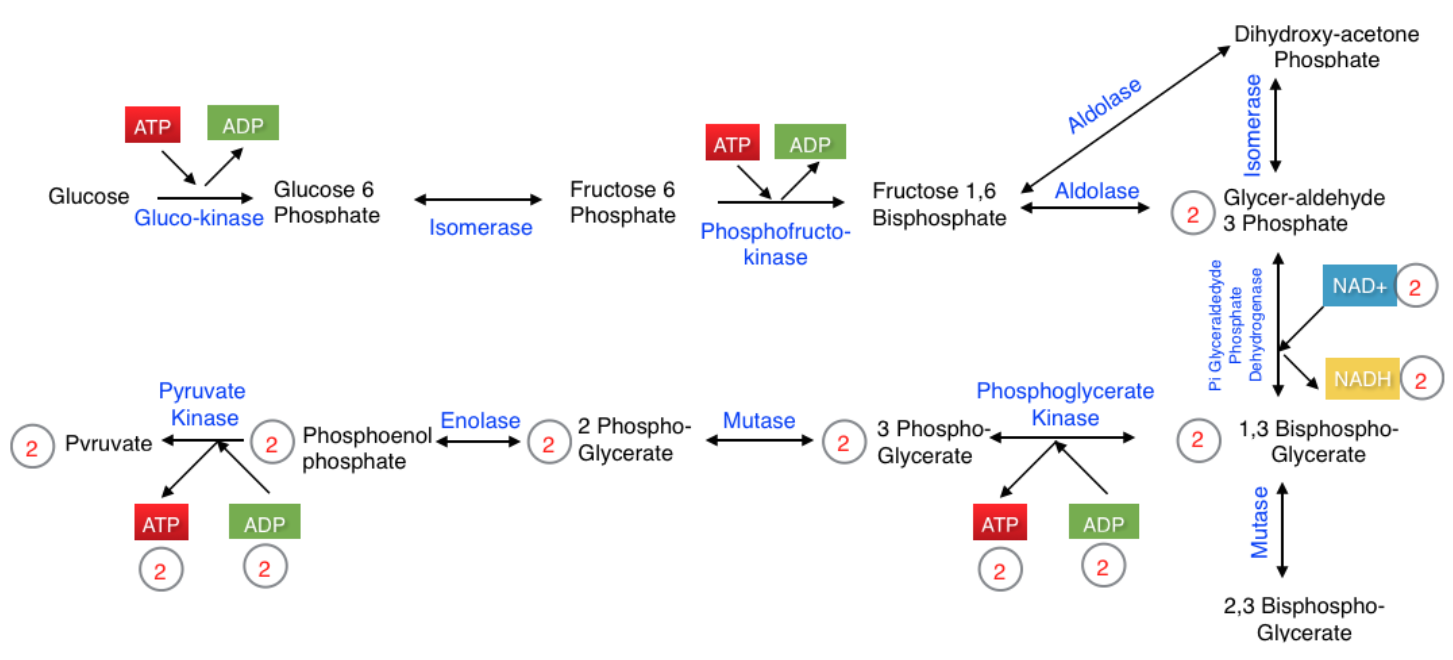
2 $NADH^+$ produced during anaerobic glycolysis yields
A. 6 ATP molecules
B. 4 ATP molecules
C. 8 ATP molecules
D. None of the above
Answer
568.5k+ views
Hint: Glycolysis is a process in which breakdown of glucose takes place to form two molecules of pyruvate.
Complete Answer:
- ATP stands for Adenosine triphosphate. It is an energy carrying molecule which is found in the cells of all living beings.
- ATP production takes place in the Mitochondria of a cell that’s why mitochondria of a cell is called a powerhouse of the cell.
- ATP captures chemical energy that is obtained from the breakdown of food molecules and we use this energy for other cellular processes.
Anaerobic glycolysis: Anaerobic glycolysis is the transformation of a glucose molecule to the lactate or lactic acid when there is no oxygen present.
- At the end of glycolysis we are with 2ATP, 2NADH (Nicotinamide adenine dinucleotide phosphate), and 2 pyruvate molecules. The NADH gets converted to ATP via the Electron Transport Chain.
- Electron Transport chain occurs in the Mitochondria of the cell in the presence of Oxygen.
- Since in anaerobic respiration there will be the absence of Oxygen then no NADH gets converted to ATP.

Diagram showing the process of glycolysis in which there is net production of 2 ATP molecules and two NADH molecules.
Hence option D is the correct answer for this question.
Note: In general, during aerobic respiration one molecule of NADH produces 2-3 ATP via electron transport chain.
Complete Answer:
- ATP stands for Adenosine triphosphate. It is an energy carrying molecule which is found in the cells of all living beings.
- ATP production takes place in the Mitochondria of a cell that’s why mitochondria of a cell is called a powerhouse of the cell.
- ATP captures chemical energy that is obtained from the breakdown of food molecules and we use this energy for other cellular processes.
Anaerobic glycolysis: Anaerobic glycolysis is the transformation of a glucose molecule to the lactate or lactic acid when there is no oxygen present.
- At the end of glycolysis we are with 2ATP, 2NADH (Nicotinamide adenine dinucleotide phosphate), and 2 pyruvate molecules. The NADH gets converted to ATP via the Electron Transport Chain.
- Electron Transport chain occurs in the Mitochondria of the cell in the presence of Oxygen.
- Since in anaerobic respiration there will be the absence of Oxygen then no NADH gets converted to ATP.

Diagram showing the process of glycolysis in which there is net production of 2 ATP molecules and two NADH molecules.
Hence option D is the correct answer for this question.
Note: In general, during aerobic respiration one molecule of NADH produces 2-3 ATP via electron transport chain.
Recently Updated Pages
A man running at a speed 5 ms is viewed in the side class 12 physics CBSE

State and explain Hardy Weinbergs Principle class 12 biology CBSE

Which of the following statements is wrong a Amnion class 12 biology CBSE

Two Planoconcave lenses 1 and 2 of glass of refractive class 12 physics CBSE

The compound 2 methyl 2 butene on reaction with NaIO4 class 12 chemistry CBSE

Bacterial cell wall is made up of A Cellulose B Hemicellulose class 12 biology CBSE

Trending doubts
What are the major means of transport Explain each class 12 social science CBSE

Which are the Top 10 Largest Countries of the World?

Explain sex determination in humans with line diag class 12 biology CBSE

Draw a labelled sketch of the human eye class 12 physics CBSE

How much time does it take to bleed after eating p class 12 biology CBSE

Suicide bags of cells are aEndoplasmic reticulum bLysosome class 12 biology CBSE




